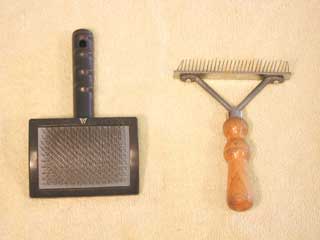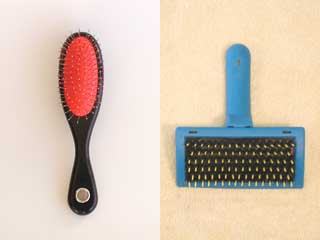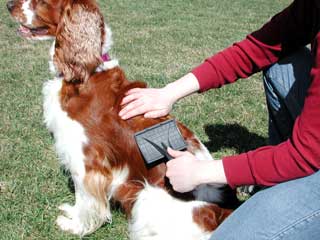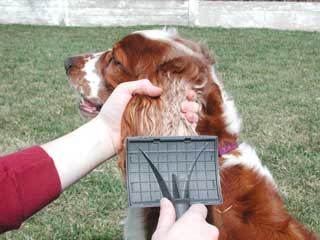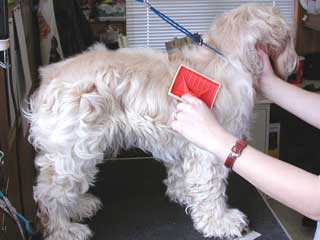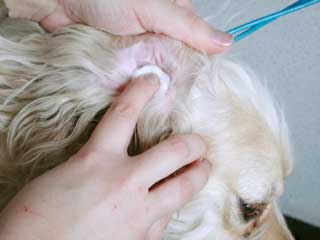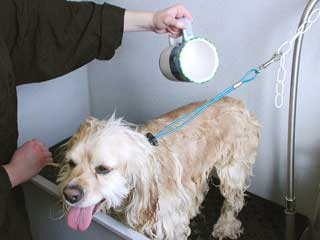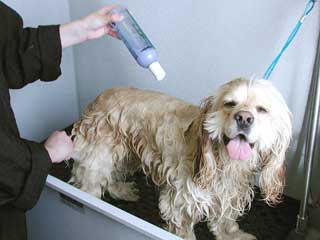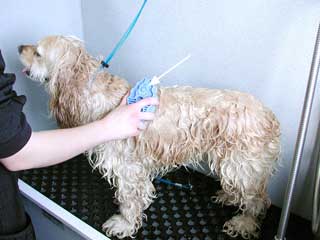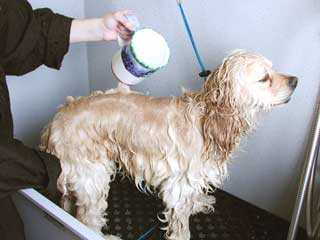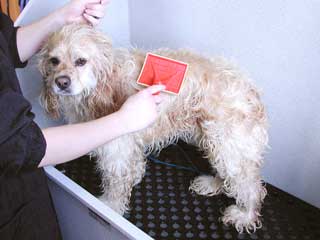short-haired breeds |
wirehaired breeds | long-haired
breeds | double-coated breeds |
bathing
Introduction: A main key to good grooming is good nutrition. Without good
nutrition the petís coat will appear dry and lifeless. All dogs require regular
bathing and brushing. Most types of hair coats can be categorized into one of
four groups: short-haired breeds, wirehaired breeds, long-haired breeds and
double-coated breeds. The type of hair coat the dog has will determine the
frequency of brushing and bathing.
Tools for Brushing and Bathing
- Shampoo and conditioner
- Slicker brush
- Wide toothed comb
- Grooming rake
- Rubber tipped pin brush
- Coat dressing or spray
- Cotton balls
* Pictures of many of these objects can be found later in this discussion.
Short-haired Breeds (Doberman pinschers, dachshunds, German shorthairs, pugs,
etc.): Even short-haired breeds will need care. Comb these breeds regularly,
especially before each bath. With short-haired breeds, use a rubber tipped,
curry-type brush. Brushing 2-3 times a week will greatly reduce shedding. It is
also helpful to rub the coat in a circular pattern while wearing a pair of latex
gloves. This loosens the dead hair and dander, which can be removed by running a
damp cloth over the pet. A car chamois cloth can also be used to collect loose
hair and dander. Short-haired breeds can be bathed 1-2 times a month, depending
on how dirty the pet gets. More frequent bathing can be done, but it may dry the
skin and hair coat.
Wirehaired Breeds (Terriers): Wirehaired coats are supposed to be hard
and crisp. Handstripping and clippering are grooming methods used to maintain
this texture. Handstripping is where the hair is held between a "stripping
blade" and the finger. The dead hair is then removed in a pulling fashion.
Clippering and handstripping are not simple techniques and can be difficult to
master. Because of this, many wirehaired dogs and especially show animals are
professionally groomed. Prior to clippering, the groomer may choose to "card"
the coat to achieve some of the benefits of handstripping, in a less time
consuming fashion. For many terrier owners, the key to proper grooming is
finding a good groomer.
It is usually recommended that terrier owners select an appropriate shampoo
and avoid conditioners. A slicker brush is often used to help detangle the coat.
In order to not soften the coat, terriers should not be bathed too regularly
(possibly only once a month).
Long-haired Breeds (Cocker spaniels, Afghans, shih tzu, etc.):
Long-haired breeds need to be brushed often. No product can eliminate brushing,
but conditioners can help reduce tangling. Most long-haired breeds have layers
of hair. A conditioner helps these layers lay properly. It is important to brush
all tangles out prior to bathing and then again when the hair is dried. Take
advantage of the metal teeth in a slicker brush to remove snarled hair. Because
it can break the hair shaft and cause some hair loss, a slicker brush should be
used with caution in show animals. For this reason, some pet owners use a "pin
brush." The pin brush, however, is difficult to use to remove mats. When
brushing long-haired breeds, it is important to use one hand to lift the hair
out of the way while brushing. For example, start at the end of the foot and
lift the longer hair fibers out of the way, while brushing down and away from
the leg (see below). When bathing,
choose a shampoo that is formulated for long coats and can reduce
static-electricity. Using a coat "detangle" spray prior to brushing can also
help. Most dogs can be bathed 1-2 times a month. More frequent bathing can be
done, but it may dry the skin and hair coat.
Double-coated Breeds (Golden retrievers, Shetland sheepdogs, Samoyeds, etc.):
Double-coated breeds have a very short undercoat with a longer outercoat.
These breeds drastically shed the dense, soft undercoat. The main challenge is
to brush out the shedding coat without matting the undercoat or having fur all
over the place. To prevent this, brush with a slicker brush and follow up with a
good combing using a metal comb with widely spaced teeth. Combing can often
prevent matting, which can be a difficult and costly problem. Divide the dog
into sections, and focus on one area until all the tangles are removed. Doing
this in a systematic fashion will help ensure that no areas are missed. Brush
the area and then comb it. If a tangle is found, brush it more until it is
detangled. Do not just brush the top layer. It is essential that the brushing
gets down to the undercoat. To help with this, the hand not holding the brush is
often used to lift the outercoat out of the way, while brushing the underlying
hair. A thorough brush and comb job can be checked by randomly selecting any
part of the body and parting the dogís hair. Skin should be easily visible
anywhere the hair is parted. If hair is seen, the undercoat in this area was
missed.
When bathing double-coated breeds, work up a lather deep into the undercoat.
Then brush the dog again while it is still lathered to help brush out the
undercoat. When rinsing, make sure all the soap is completely rinsed out.
Double-coated breeds may need to be bathed 1-2 times a month. Like the other
hair types, more frequent bathing can be done, but it may dry the skin and hair
coat.
* After brushing and bathing it is important to reward all breeds with lots
of love and affection. The brushing and bathing experience should be a
positive one for both the dog and the owner.
Bathing: To help keep pet odors down and to keep the coat and skin
healthy, it is important to bathe a pet on a regular basis. The frequency of
each bathing will depend on the length of the dogís coat and the environment in
which the dog lives. In general, most dogs can be bathed 1-2 times a month,
depending on how dirty the pet gets. More frequent bathing can be done, but it
may dry the skin and hair coat. The following points and pictures will help in
bathing a pet:
Bathing Checklist
- Before bathing, always brush the dog's hair. This will loosen the dirt and
brush out dead hair.
- Select a good shampoo. Because the pH of a dog's hair is different from
human hair, using human shampoos on dogs can contribute to dry, itchy skin.
Select a dog shampoo that is tearless and hypo-allergenic. Select one that is
formulated specifically for the petís type of coat (long, short, wirehaired,
etc.).
- Begin by wetting the dog. Do not fill the tub or sink with water. Simply
use a hose sprayer or plastic cup.
- Do not leave the dog alone.
- Cotton balls placed in the ears can be used to keep water out.
- Pour the shampoo onto the dog. Begin on the back of the neck and head.
- Keep the shampoo out of the dog's eyes.
- Work up a good lather on the entire dog.
- For longer haired breeds, it is often helpful to use a brush to help work
the shampoo into the deeper layers of the coat and remove dead undercoat.
- Rinse until squeaky-clean.
- Pat the dog dry with a towel. Rubbing and moving the towel in
circular motions has the tendency to cause the hair to tangle.
- Place the dog in a warm area and allow the hair to completely dry.
- Brush the dog once the hair is dry.
- Apply a coat dressing or spray when necessary.
- After bathing, when the water has softened the nails, it is a good time to
clip the nails.
Much of the above information was taken from the following reference: Mohler,
Diana. "Managing the 4 Coat Types." Dogs USA 18 (2003): 94-101.
